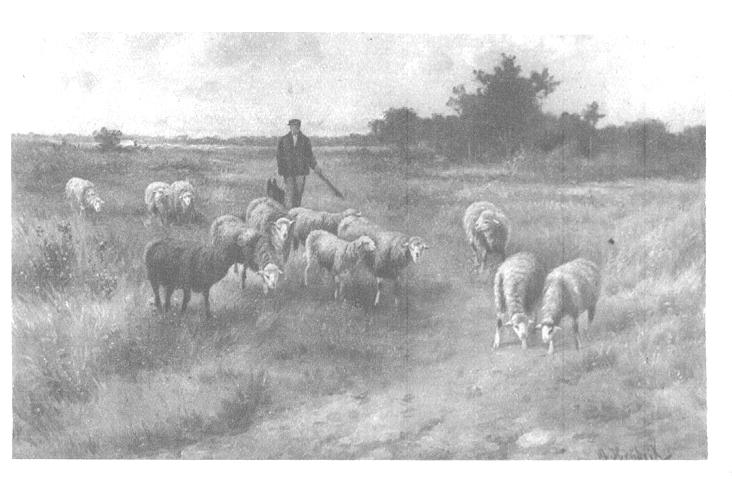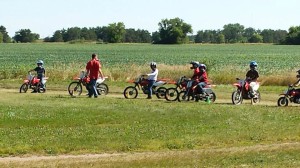The Farms ~ Part II
The YMCA’s interest in the Bertram Chain of Lakes land first came from donations/purchases by the Lehigh Cement company which owned land on the east side of the lakes, including First Lake.
During the next 15 years (from 1952-1967) neighboring farms were bought up as they began to cease operations. Most of these farms were small one-family operations of dairy, small grain, sheep and cattle and provided a life for these families for almost 100+ years (from 1850-1950+).
These farms were purchased one at a time until the current land area of the Bertram Chain of Lakes was created. All together there are nine (9) farmsteads that can be located on the land, several of which have old foundations and other remains to show where they were.
In the future when all of the land has been purchased and the entire natural area of the park is open to the public, these farmsteads will be marked showing the last two farmers/owners of the land.
Several of these farms produced some specialty crops:
- The corner of Briarwood & 90th Street (horse pasture) was originally a field where sheep were raised for many years. They produced wool, mutton & chops.
- Inside the south entrance and just southeast of the parking lot was the site of a very specific crop; this was the site of a mink farm. The pelts of the mink were used for coats and stoles. Changing attitudes led to its demise.
- Rumor has it that there was a celery farm located near Long Lake but the specific location has not been found.
- Of course,m the YMCA used the land to farm Christmas trees for sale in the cities. Several of the areas are still in existence today but will be redone in the future.
We must be sure to remember and celebrate these early stewards of the land!
The George Bertram Family Tree
To begin looking at George Bertram’s family, we must back up one generation to his parents, Andrew Bartram and his wife, Alison Monilaws Bartram. Andrew and Alison Bartram immigrated to the United States from Glasgow, Scotland in 1812. George was one of four boys and six girls born to Andrew and Alison, and he was born March 4, 1820.
George married Julia Hamilton on September 30, 1841 in Newark, New Jersey and their family tree is as follows:
* Thomas was born 4 months after Minnesota became a state!
YMCA Detached Worker
 I first became aware of this phase in the mid 1970’s when a YMCA Detached Worker was assigned to the Monticello area through the Manitou Camp, located on the south end of Bertram Lake. A worker by the name of Mike M. came to the Monticello High School and introduced himself to be the YMCA person who would be coordinating programs in the schools in conjunction with Camp Manitou. The YMCA has always been instrumental in the social issues of children and created the Detached Worker Program to help struggling children with school, home and personal issues. I asked Mike where the “Detached Worker” part came in because I didn’t see him coming “apart” in any way! We laughed and he explained that he was a YMCA employee but that he had no office or specific role other than to help disadvantaged, neglected and/or forgotten children who needed help, guidance, structure, and a person to care about them. Since the detached worker was not restricted to hours, he or she could work with children of all ages and at all times ~ especially afternoons and evenings outside of regular school times.
I first became aware of this phase in the mid 1970’s when a YMCA Detached Worker was assigned to the Monticello area through the Manitou Camp, located on the south end of Bertram Lake. A worker by the name of Mike M. came to the Monticello High School and introduced himself to be the YMCA person who would be coordinating programs in the schools in conjunction with Camp Manitou. The YMCA has always been instrumental in the social issues of children and created the Detached Worker Program to help struggling children with school, home and personal issues. I asked Mike where the “Detached Worker” part came in because I didn’t see him coming “apart” in any way! We laughed and he explained that he was a YMCA employee but that he had no office or specific role other than to help disadvantaged, neglected and/or forgotten children who needed help, guidance, structure, and a person to care about them. Since the detached worker was not restricted to hours, he or she could work with children of all ages and at all times ~ especially afternoons and evenings outside of regular school times.
Some of the activities included camping trips, group work, volunteer activities, sports, games, and family referrals. One very popular program the Mini Bike Program. The YMCA had secured a partnership with Honda to provide some mini bikes to Camp Manitou. Each year students would learn about the bikes and how to handle and ride them safely. After the basic introduction, they would practice riding them in an oval to help them hone their skills. The final result was to go on a trail ride throughout the YMCA-Bertram property. In the end they would clean and maintain the bikes for the next trail ride; similar to the book, “Zen and Art of Motorcycle Maintenance”, except they were mini bikes. This program lasted over 25 years and educated hundreds of children in the Monticello area on mini bike safety.
Cecropia Moth
 When looking at and remembering history, we are too often forced to look at it in human terms but, plants, insects and animals have always had their own influences, in in some instances, very serious impact on human history. In this case, I had a very interesting and beautiful encounter with an insect in the Bertram Lakes area.
When looking at and remembering history, we are too often forced to look at it in human terms but, plants, insects and animals have always had their own influences, in in some instances, very serious impact on human history. In this case, I had a very interesting and beautiful encounter with an insect in the Bertram Lakes area.
It was the summer of 1990, while supervising some summer youth employment students. We were engaged in some cleanup near the beach area of Bertram Lake. A storm had come through and left some of the oak trees with broken branches and scattered leaves. One of the older trees ha d received a lightning strike that left it in fairly bad shape. We had decided that it needed to come down and proceeded to trim all the branches away. As I began using the chainsaw on the upper trunk, I felt little resistance to the saw. It soon became apparent that the tree was hollow and in fact, very hollow. After cutting several feet off the upper trunk we could look inside and see that the entire bottom was covered, 3 feet deep, with course sawdust. In looking through the sawdust, I found several (6-10) very large larvae, all about the size of a finger. They were off-white with a faint green hue and about 3/4 of an inch thick. They could be nothing less than the larvae of the Cecropia Moth. The largest of the moth family in North America. Recognizing this, we stopped cutting, covered the top with branches and leaves and left it alone until the next year.
d received a lightning strike that left it in fairly bad shape. We had decided that it needed to come down and proceeded to trim all the branches away. As I began using the chainsaw on the upper trunk, I felt little resistance to the saw. It soon became apparent that the tree was hollow and in fact, very hollow. After cutting several feet off the upper trunk we could look inside and see that the entire bottom was covered, 3 feet deep, with course sawdust. In looking through the sawdust, I found several (6-10) very large larvae, all about the size of a finger. They were off-white with a faint green hue and about 3/4 of an inch thick. They could be nothing less than the larvae of the Cecropia Moth. The largest of the moth family in North America. Recognizing this, we stopped cutting, covered the top with branches and leaves and left it alone until the next year.
I can only hope that they all survived. I was very happy and awed to see how nature compliments itself by providing what is necessary for its components to survive. Beauty isn’t always in what we can see, but it’s hidden all around us!
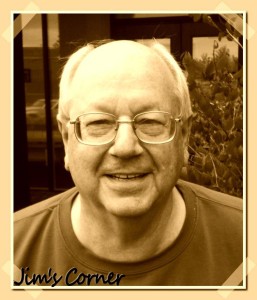
Apprentice Tailor – George Bertram
After living for 10-12 years on their rented farm in Delhi, the Andrew and Alison Bartram family moved to New York City. Perhaps, this was out of necessity or simply to have better opportunities for their family, but by 1832, they were living in New York City.
With the downturn of the economy in 1833, George, at the age of 13, and with the consent of his father, was bound as an apprentice to serve for seven years under Andrew Little, Tailor.
The certificate of indenture lists George as being 13 years, 11 months, 4 days of age and his term of service to end December 1840. The contract wording is interesting, for it states, “The Apprentice is to serve his Master faithfully, to keep his secrets, to obey his lawful commands, and neither to gamble, nor drink, nor commit matrimony within the times”. “In return, the Master agrees to teach the Art, Trade and Mystery of the tailor, to provide sufficient meat, drink, washing, lodging and clothing fitting for an Apprentice” and also to give him two quarters of evening schooling in the term.
At this time in history, apprenticeships were considered very serious business and rewards were often offered for “lost, strayed or stolen” apprentices!
For the first two years of the apprenticeship, George’s tasks would have included: hauling wood and water, sweeping the shop, stocking and putting in order blocks of clothes, picking up pins and needles and other necessary tasks to help the Master. As time went by, he would have learned the “mysteries” of measuring, cutting, basting, pressing, fitting, sewing and button-holeing.
George persevered and on May 1, 1840, Andrew Little released him from his contract in consideration for his “uniform good conduct, for his honesty, truth, integrity and sobriety”.
George Bertram (new spelling as mentioned in an earlier tidbit) continued as a journeyman tailor for the next several years but little is mentioned as to which shops he may have been employed at. During this time he met and married Julia Hamilton and began his family.
Land Ordinance of 1785
In 1784, the Continental Congress had a perplexing situation to deal with. Under the Articles of Confederation, Congress did not have the ability to raise revenue through taxation. The only way out was to sell land that was available in the then Northwest Territory. Because of this, the then Continental Congress created the Land Ordinance of 1785, an effort led by Thomas Jefferson, for the dispersement of the land.
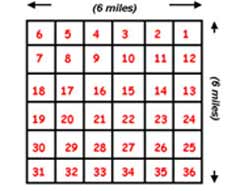
In order to sell the new land there needed to be a method developed for its distribution. The New England Colonies were created on the basis of community development and systematic planning, while the Southern Colonies followed a free flowing individualistic system. The Ordinance authors chose to reflect the New England system and by doing so, developed the Township Pattern that is still used today. Under this system, townships were laid out in squares, 6 miles on a side with each divided into 36 sections (see diagram at right).
Each 1 square mile = 640 acres.
As the new county of the United States progressed and land became available through treaties with the Native Americans, new states were formed and the land was available (through the government) to settlers.
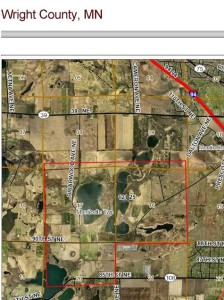
Why do I mention all of this? Because, in 1862, with the establishment of the Homestead Act, land became available for very low prices and because of the Civil War, George Bertram was granted land at the south of end of Bertram Lake. It included land in the NE corner of section 20 and land in the SE corner of section 17.
It should also be noted that the Land Ordinance of 1785 established that Section 16 of each Township be set aside for education. Section 16 of Monticello Township includes most of Long Lake and the land east of it, which when sold, the proceeds going to help pay for the building of the school in Monticello.and the land was available (through the government) to settlers. The states of Ohio, Indiana, Illinois, Wisconsin and Minnesota were established as the land became available. The Treaty of Traverse du Souix (1851) allowed land to be plotted according to the township system and in time, the county of Wright and Monticello Township were established.
Note to Ponder: How do you establish a flat, square grid on a round globe?
Over the River and through the Woods to Bertram Lakes we go?
This tidbit is definitely longer than all of the others but please take a little time to read it. I ran across it while doing research at the Wright County Historical Society and it speaks well to what was in the mind of many settlers to the area in the late 1800’s. It’s from an unpublished work by Henry Schermer that is located at the WCHS.
“The conductor called out, “Big Lake”, and we picked up our bundles for the last time and left the train. Pa first found our stage man which did not take as long as Big Lake was only a small station. There were not many people there and I saw Pa shaking hands with a tall slim man. They both talked Dutch, and Pa introduced mother to him and I heard them say his name was Brot. He caught sight of my brother and me and he told father that he had two nice boys, and I winked at my brother. After a little talking, Mr. Brot said we had better load up and all got into his wagon, and our baggage was put in another wagon driven by some Yankee who I noticed was smiling to himself, thinking, I suppose, that we were an awfully green lot of Dutchmen, and that Uncle Sam should never allow such people in the United States. Here we started on our first ride by stage, and I don’t tell a lie when I say that we were somewhat afraid sitting up there in the ugly looking Yankee wagons drawn by a pair of horses that looked as if they hadn’t seen a bite to eat for a week. As we were getting on, those horses were pawing and jumping around as if they were crazy and I asked Pa if there were Yankee horses and he said that all horses in this country were like that. Then Pa told me to keep still and I did so. As we were getting into the wagon, mother climbed in first and then some of the babies and then father climbed in so as to get a good safe place for himself. Last of all, Pete and I got on, and I’ll say right here that I didn’t look for the highest place on the wagon, but dug myself pretty well to the bottom. Finally, we started on the jump and mother began to holler not to go so fast.
I stuck my head out to see what the matter was already so soon. Mr. Brot was not afraid and told mother not to be afraid and told her that everything was all right. We were driving along a smooth prairie road without a hill in sight and were getting somewhat accustomed to riding in a wagon. I was just beginning to feel safe myself and was taking in the sights when all at once I saw a large stream of water before us with no bridge across it. We thought that he was going to drive right through it and mother and I called out to him to stop and he did stop. He told us not to be afraid as we were going to cross on a ferry boat. And as we looked across the river we saw the ferry boat coming across from the other side to get us. But we would not stand for it. and talk as Pa and Mr. Brot would, mother and us children would not go across. At last it was decided that the teams would go across so that we could see how safe it was. I noticed that father was angry at our being such cowards and said that he would show us that he was not afraid to cross. so when the ferry got on our side of the river, the teams drove on and the Yankee driving the baggage wagon smiled as he drove past us. Father stood in the middle of the boat, looking wild and pretty soon sat down flat and hung onto some ropes for dear life, never saying a word all the way across. But just as soon as he saw that he was but a few feet from shore, he got up and called ou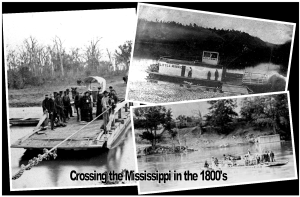 t to us in Dutch, “You cowards”.
t to us in Dutch, “You cowards”.
After the wagons drove off, the ferry started back to get us. We wanted Pa to come over and get us but he said no, it was better for Mr. Brot to come after us as he could talk Yankee to the boatman if he should go too fast to suit us. So, Mr. Brot came over and we had to get on as there was no help for it. We all walked on the ferry feeling that this would be our last walk on earth. We all gathered in a little group in the center of the ferry and sat down just as Pa had done. We admitted that we were cowards, but he would not give in. I suppose that father thought he was getting so Americanized that he could ring in one of those Yankee bluffs on us. As we reached the other side of the river, I heard mother off up a little prayer of thanks to Him who is in America as well as in in Dutchland.
There is nothing more precious in the world to you or to me than our praying mothers and I wish that every boy and girl could say that they have a praying mother. So we loaded up once more and drove to a little village called Monticello and here we stopped for dinner. Mr. Brot, being acquainted there and able to talk English, ordered dinner for us and I am sure that he told them to do their bets for us for as rule, they do not treat greenhorns any too good. But here we had the best meal we had since the minister made the farewell speech, and as we had left St. Paul hungry, it looked good to us to get a table full of good things. And besides, we had a Hollander sitting with us and if everything did not go all right, he could talk to them in English, and that made me feel easy. As we were eating I noticed the Yankee baggage wagon driver was sticking his knife in his mouth and I said to my brother, “Look, that fell is trying to stick himself”. Finally, I got the boys and Pa and Mr. Brot to look at him and Mr. Brot laughed and said that was nothing as they all ate with their knives in this country, as that is the custom. Yes, and we found many other queer customs to get used to in this country. After we had our dinners and the crazy horses had theirs, we started once more on our journey. We had ten miles more to go before we would get to where Pa wanted to look around for land. We drove over hills, sloughs, stumps and rocks and it was one of those hot April days. We came to a steep hill and Mr. Brot had to stop and let us all out as we wanted to see what the country was like. We did not believe in sitting in that wagon with a span of horses in front trying to break our necks as were going down the steep hills. I don’t believe you will blame us for being afraid as it was something we were not used to. On this trip there certainly were some awful steep ones. When got to the top and could look down, it looked very bad and we felt safer walking. So every time we got to a hill we got out and walked, but I will say that any Swede, Norwegian, German or Dane would have done the same thing.
Well, I may have to take back about the Norwegians, as Norway is nothing but mountains and they probably would not be afraid. But after all our screaming and talking, we at last got to our journey’s end.”
What a great story … but maybe, just maybe, those hills, sloughs, stumps and rocks included the Bertram Lakes area because the destination of this journey was just north of Maple Lake!
Oops!
 There are times in life’s journey when we are traveling along just fine and all of a sudden … Oops!
There are times in life’s journey when we are traveling along just fine and all of a sudden … Oops!
This happened at the YMCA Camp on September 26, 1986 – The “Gas Spill”.
Let me back up. In September of 1946, the Standard Oil Company received a right-of-way easement to install a gasoline pipeline through the NE corner of the property. The easement was re-assigned to the American Oil Company in 1960. There were no incidents with the pipeline for the next 26 years, until the “oops” occurred.
In September of 1986, a landscape company was given permission by the YMCA to purchase and remove larger 10′ to 15′ spruce trees from the property for use in their business. The landscaper was shown where to dig the trees and was also shown the location of the pipeline. But, if you have ever been to a Christmas tree farm in search of the “perfect” live tree, you know that the one “over there” looks better and soon you are far from where you started.
Eventually, the landscaper found the better tree and dug one up right over the pipeline. As a result, he cut into the pipeline and created the gas spill. In all, 23,000 gallons of unleaded premium gasoline were released into the sandy soil before the line could be shut down!
The cleanup of the land lasted over the next several years. However, due to the technology used, the extraction of the gasoline was nearly 100% and cleaner soil was hauled in to replace the contaminated soil.
All in all, it was an unfortunately “Oops” but fortunately was remedied properly!
